Integrating Foodscaping in Melbourne High-Rise Residential Buildings
VerifiedAdded on 2021/04/16
|44
|11538
|401
Project
AI Summary
This architecture project investigates the integration of edible landscapes, specifically focusing on high-rise residential buildings in Melbourne, Australia. The research addresses the rapid urbanization and subsequent loss of greenery, aiming to conserve native plant species by incorporating foodscaping. The project explores the use of edible landscapes to bring back greenery, conserve native plants, and improve the quality of life for residents. The research includes a literature review, methodology, and critical analysis of precedent studies such as the Edible Schoolyard, the McGill University project, and Sky at One Central Park. The project proposes systems for integrating edible landscapes, considering growing, maintaining, and harvesting, with the goal of increasing access to food, reducing stress, and fostering community interaction within residential buildings. The expected outcomes include the conservation of native plants, restoration of greenery, and improved access to healthy food for residents, helpful for students and tourists to study about natural heritage and improve healthy environment in the city.
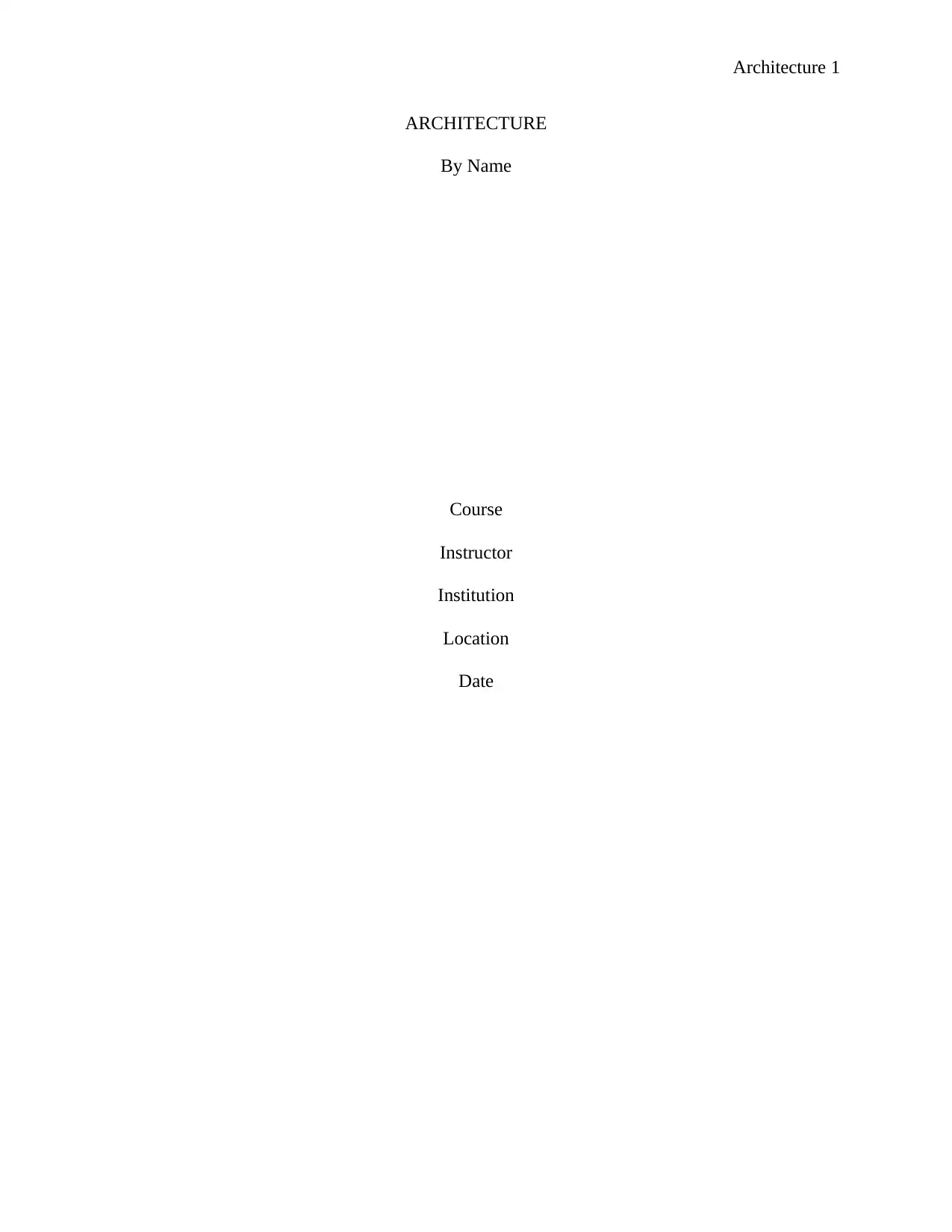
Architecture 1
ARCHITECTURE
By Name
Course
Instructor
Institution
Location
Date
ARCHITECTURE
By Name
Course
Instructor
Institution
Location
Date
Paraphrase This Document
Need a fresh take? Get an instant paraphrase of this document with our AI Paraphraser
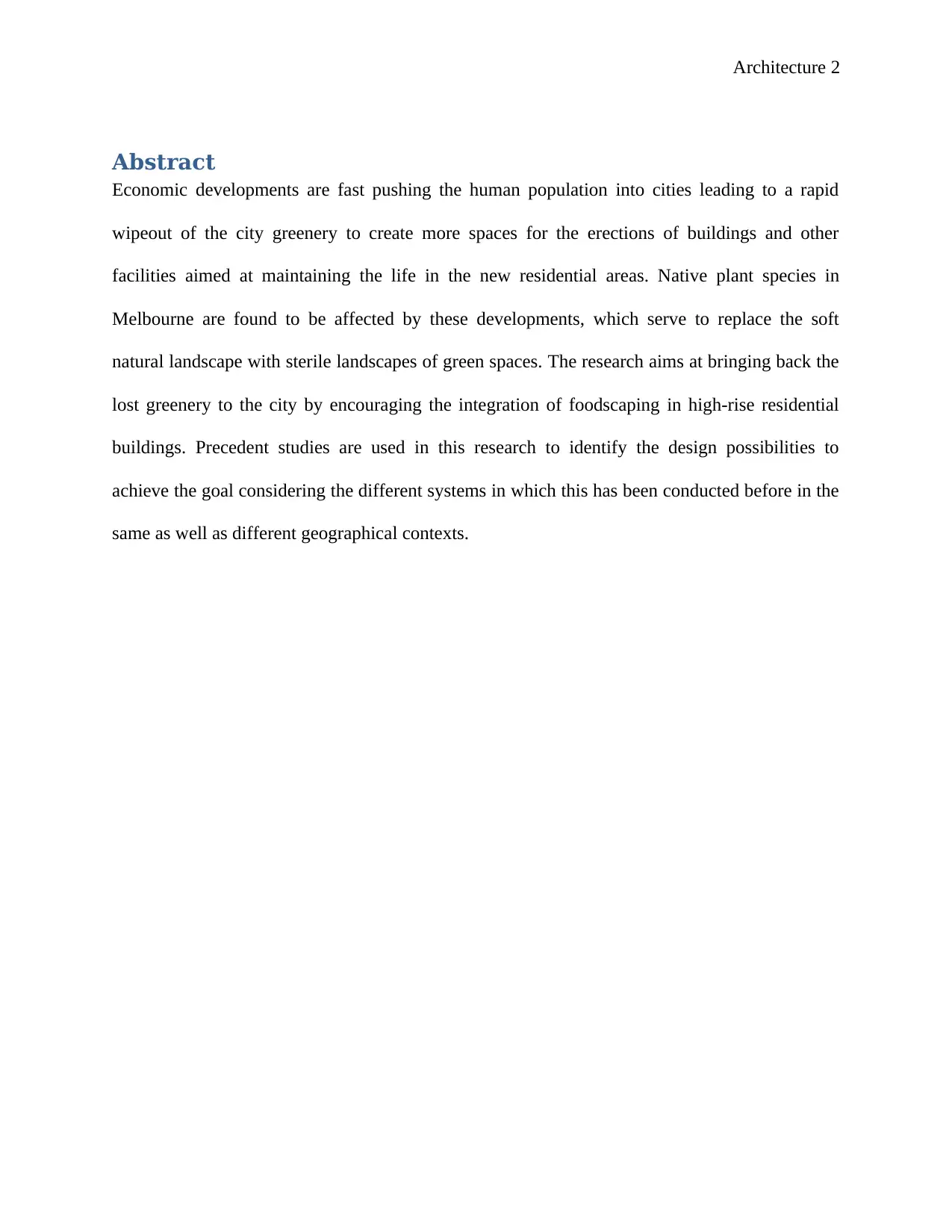
Architecture 2
Abstract
Economic developments are fast pushing the human population into cities leading to a rapid
wipeout of the city greenery to create more spaces for the erections of buildings and other
facilities aimed at maintaining the life in the new residential areas. Native plant species in
Melbourne are found to be affected by these developments, which serve to replace the soft
natural landscape with sterile landscapes of green spaces. The research aims at bringing back the
lost greenery to the city by encouraging the integration of foodscaping in high-rise residential
buildings. Precedent studies are used in this research to identify the design possibilities to
achieve the goal considering the different systems in which this has been conducted before in the
same as well as different geographical contexts.
Abstract
Economic developments are fast pushing the human population into cities leading to a rapid
wipeout of the city greenery to create more spaces for the erections of buildings and other
facilities aimed at maintaining the life in the new residential areas. Native plant species in
Melbourne are found to be affected by these developments, which serve to replace the soft
natural landscape with sterile landscapes of green spaces. The research aims at bringing back the
lost greenery to the city by encouraging the integration of foodscaping in high-rise residential
buildings. Precedent studies are used in this research to identify the design possibilities to
achieve the goal considering the different systems in which this has been conducted before in the
same as well as different geographical contexts.
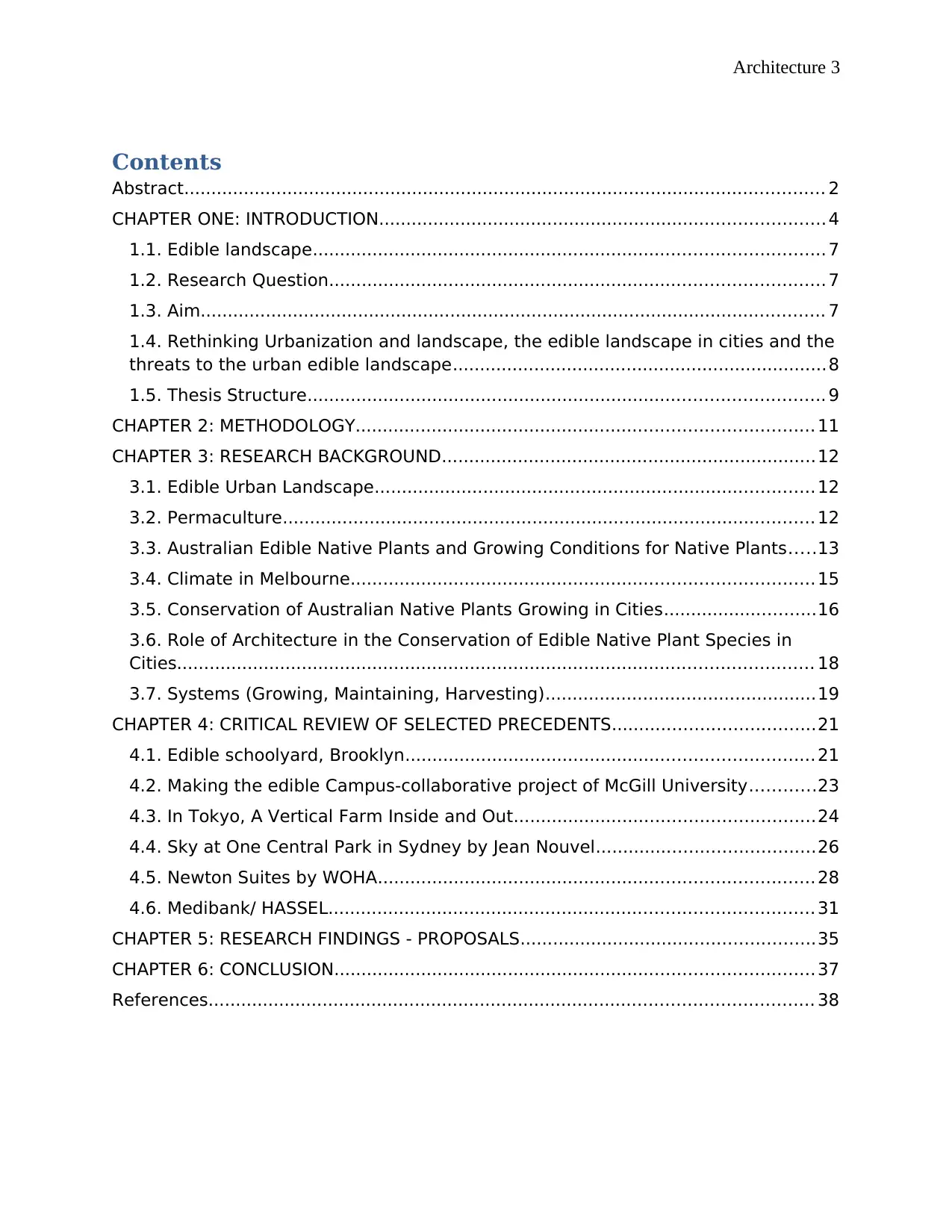
Architecture 3
Contents
Abstract...................................................................................................................... 2
CHAPTER ONE: INTRODUCTION.................................................................................. 4
1.1. Edible landscape.............................................................................................. 7
1.2. Research Question........................................................................................... 7
1.3. Aim................................................................................................................... 7
1.4. Rethinking Urbanization and landscape, the edible landscape in cities and the
threats to the urban edible landscape.....................................................................8
1.5. Thesis Structure............................................................................................... 9
CHAPTER 2: METHODOLOGY.................................................................................... 11
CHAPTER 3: RESEARCH BACKGROUND.....................................................................12
3.1. Edible Urban Landscape................................................................................. 12
3.2. Permaculture.................................................................................................. 12
3.3. Australian Edible Native Plants and Growing Conditions for Native Plants.....13
3.4. Climate in Melbourne..................................................................................... 15
3.5. Conservation of Australian Native Plants Growing in Cities............................16
3.6. Role of Architecture in the Conservation of Edible Native Plant Species in
Cities..................................................................................................................... 18
3.7. Systems (Growing, Maintaining, Harvesting)..................................................19
CHAPTER 4: CRITICAL REVIEW OF SELECTED PRECEDENTS.....................................21
4.1. Edible schoolyard, Brooklyn...........................................................................21
4.2. Making the edible Campus-collaborative project of McGill University............23
4.3. In Tokyo, A Vertical Farm Inside and Out.......................................................24
4.4. Sky at One Central Park in Sydney by Jean Nouvel........................................26
4.5. Newton Suites by WOHA................................................................................ 28
4.6. Medibank/ HASSEL......................................................................................... 31
CHAPTER 5: RESEARCH FINDINGS - PROPOSALS......................................................35
CHAPTER 6: CONCLUSION........................................................................................ 37
References............................................................................................................... 38
Contents
Abstract...................................................................................................................... 2
CHAPTER ONE: INTRODUCTION.................................................................................. 4
1.1. Edible landscape.............................................................................................. 7
1.2. Research Question........................................................................................... 7
1.3. Aim................................................................................................................... 7
1.4. Rethinking Urbanization and landscape, the edible landscape in cities and the
threats to the urban edible landscape.....................................................................8
1.5. Thesis Structure............................................................................................... 9
CHAPTER 2: METHODOLOGY.................................................................................... 11
CHAPTER 3: RESEARCH BACKGROUND.....................................................................12
3.1. Edible Urban Landscape................................................................................. 12
3.2. Permaculture.................................................................................................. 12
3.3. Australian Edible Native Plants and Growing Conditions for Native Plants.....13
3.4. Climate in Melbourne..................................................................................... 15
3.5. Conservation of Australian Native Plants Growing in Cities............................16
3.6. Role of Architecture in the Conservation of Edible Native Plant Species in
Cities..................................................................................................................... 18
3.7. Systems (Growing, Maintaining, Harvesting)..................................................19
CHAPTER 4: CRITICAL REVIEW OF SELECTED PRECEDENTS.....................................21
4.1. Edible schoolyard, Brooklyn...........................................................................21
4.2. Making the edible Campus-collaborative project of McGill University............23
4.3. In Tokyo, A Vertical Farm Inside and Out.......................................................24
4.4. Sky at One Central Park in Sydney by Jean Nouvel........................................26
4.5. Newton Suites by WOHA................................................................................ 28
4.6. Medibank/ HASSEL......................................................................................... 31
CHAPTER 5: RESEARCH FINDINGS - PROPOSALS......................................................35
CHAPTER 6: CONCLUSION........................................................................................ 37
References............................................................................................................... 38
⊘ This is a preview!⊘
Do you want full access?
Subscribe today to unlock all pages.

Trusted by 1+ million students worldwide

Architecture 4
Paraphrase This Document
Need a fresh take? Get an instant paraphrase of this document with our AI Paraphraser
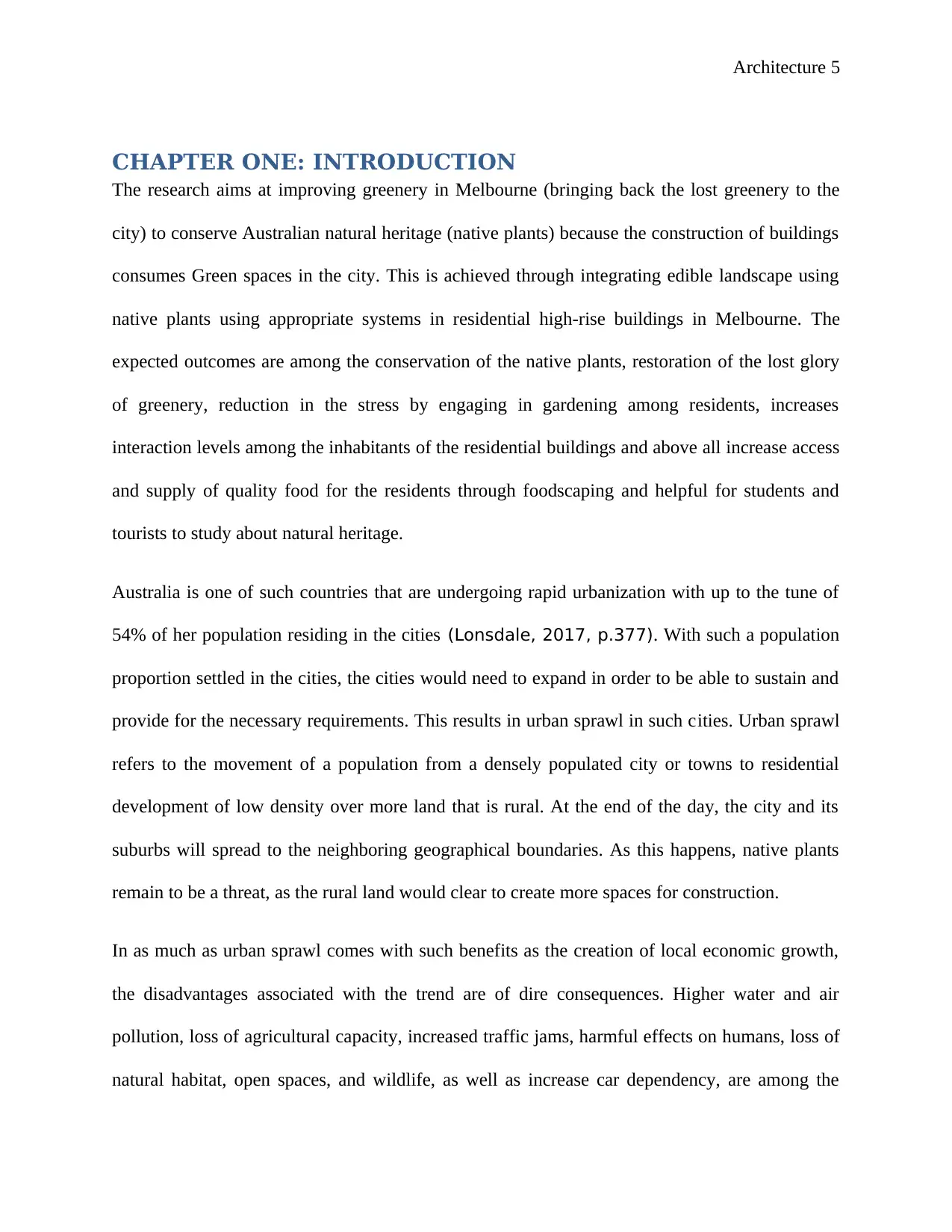
Architecture 5
CHAPTER ONE: INTRODUCTION
The research aims at improving greenery in Melbourne (bringing back the lost greenery to the
city) to conserve Australian natural heritage (native plants) because the construction of buildings
consumes Green spaces in the city. This is achieved through integrating edible landscape using
native plants using appropriate systems in residential high-rise buildings in Melbourne. The
expected outcomes are among the conservation of the native plants, restoration of the lost glory
of greenery, reduction in the stress by engaging in gardening among residents, increases
interaction levels among the inhabitants of the residential buildings and above all increase access
and supply of quality food for the residents through foodscaping and helpful for students and
tourists to study about natural heritage.
Australia is one of such countries that are undergoing rapid urbanization with up to the tune of
54% of her population residing in the cities (Lonsdale, 2017, p.377). With such a population
proportion settled in the cities, the cities would need to expand in order to be able to sustain and
provide for the necessary requirements. This results in urban sprawl in such cities. Urban sprawl
refers to the movement of a population from a densely populated city or towns to residential
development of low density over more land that is rural. At the end of the day, the city and its
suburbs will spread to the neighboring geographical boundaries. As this happens, native plants
remain to be a threat, as the rural land would clear to create more spaces for construction.
In as much as urban sprawl comes with such benefits as the creation of local economic growth,
the disadvantages associated with the trend are of dire consequences. Higher water and air
pollution, loss of agricultural capacity, increased traffic jams, harmful effects on humans, loss of
natural habitat, open spaces, and wildlife, as well as increase car dependency, are among the
CHAPTER ONE: INTRODUCTION
The research aims at improving greenery in Melbourne (bringing back the lost greenery to the
city) to conserve Australian natural heritage (native plants) because the construction of buildings
consumes Green spaces in the city. This is achieved through integrating edible landscape using
native plants using appropriate systems in residential high-rise buildings in Melbourne. The
expected outcomes are among the conservation of the native plants, restoration of the lost glory
of greenery, reduction in the stress by engaging in gardening among residents, increases
interaction levels among the inhabitants of the residential buildings and above all increase access
and supply of quality food for the residents through foodscaping and helpful for students and
tourists to study about natural heritage.
Australia is one of such countries that are undergoing rapid urbanization with up to the tune of
54% of her population residing in the cities (Lonsdale, 2017, p.377). With such a population
proportion settled in the cities, the cities would need to expand in order to be able to sustain and
provide for the necessary requirements. This results in urban sprawl in such cities. Urban sprawl
refers to the movement of a population from a densely populated city or towns to residential
development of low density over more land that is rural. At the end of the day, the city and its
suburbs will spread to the neighboring geographical boundaries. As this happens, native plants
remain to be a threat, as the rural land would clear to create more spaces for construction.
In as much as urban sprawl comes with such benefits as the creation of local economic growth,
the disadvantages associated with the trend are of dire consequences. Higher water and air
pollution, loss of agricultural capacity, increased traffic jams, harmful effects on humans, loss of
natural habitat, open spaces, and wildlife, as well as increase car dependency, are among the
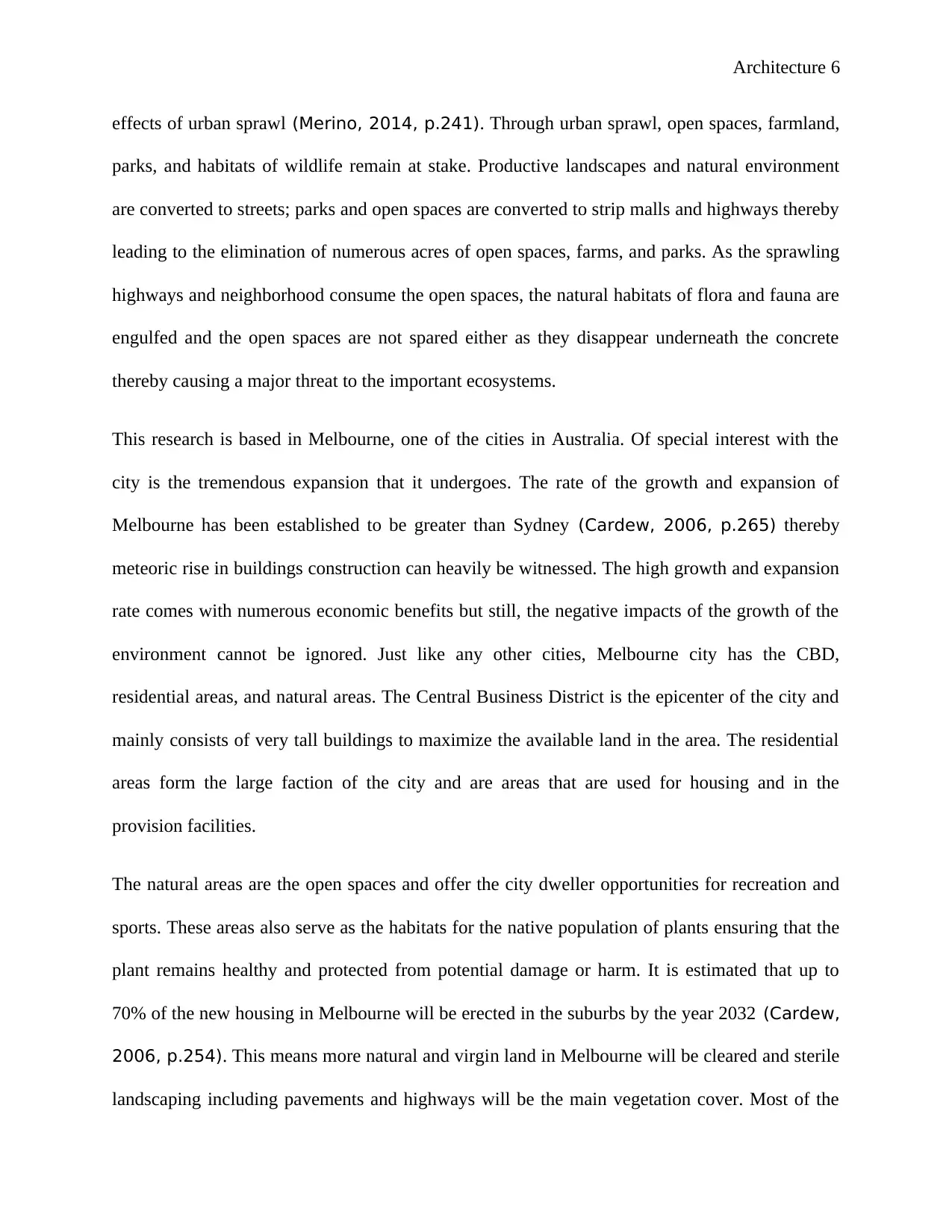
Architecture 6
effects of urban sprawl (Merino, 2014, p.241). Through urban sprawl, open spaces, farmland,
parks, and habitats of wildlife remain at stake. Productive landscapes and natural environment
are converted to streets; parks and open spaces are converted to strip malls and highways thereby
leading to the elimination of numerous acres of open spaces, farms, and parks. As the sprawling
highways and neighborhood consume the open spaces, the natural habitats of flora and fauna are
engulfed and the open spaces are not spared either as they disappear underneath the concrete
thereby causing a major threat to the important ecosystems.
This research is based in Melbourne, one of the cities in Australia. Of special interest with the
city is the tremendous expansion that it undergoes. The rate of the growth and expansion of
Melbourne has been established to be greater than Sydney (Cardew, 2006, p.265) thereby
meteoric rise in buildings construction can heavily be witnessed. The high growth and expansion
rate comes with numerous economic benefits but still, the negative impacts of the growth of the
environment cannot be ignored. Just like any other cities, Melbourne city has the CBD,
residential areas, and natural areas. The Central Business District is the epicenter of the city and
mainly consists of very tall buildings to maximize the available land in the area. The residential
areas form the large faction of the city and are areas that are used for housing and in the
provision facilities.
The natural areas are the open spaces and offer the city dweller opportunities for recreation and
sports. These areas also serve as the habitats for the native population of plants ensuring that the
plant remains healthy and protected from potential damage or harm. It is estimated that up to
70% of the new housing in Melbourne will be erected in the suburbs by the year 2032 (Cardew,
2006, p.254). This means more natural and virgin land in Melbourne will be cleared and sterile
landscaping including pavements and highways will be the main vegetation cover. Most of the
effects of urban sprawl (Merino, 2014, p.241). Through urban sprawl, open spaces, farmland,
parks, and habitats of wildlife remain at stake. Productive landscapes and natural environment
are converted to streets; parks and open spaces are converted to strip malls and highways thereby
leading to the elimination of numerous acres of open spaces, farms, and parks. As the sprawling
highways and neighborhood consume the open spaces, the natural habitats of flora and fauna are
engulfed and the open spaces are not spared either as they disappear underneath the concrete
thereby causing a major threat to the important ecosystems.
This research is based in Melbourne, one of the cities in Australia. Of special interest with the
city is the tremendous expansion that it undergoes. The rate of the growth and expansion of
Melbourne has been established to be greater than Sydney (Cardew, 2006, p.265) thereby
meteoric rise in buildings construction can heavily be witnessed. The high growth and expansion
rate comes with numerous economic benefits but still, the negative impacts of the growth of the
environment cannot be ignored. Just like any other cities, Melbourne city has the CBD,
residential areas, and natural areas. The Central Business District is the epicenter of the city and
mainly consists of very tall buildings to maximize the available land in the area. The residential
areas form the large faction of the city and are areas that are used for housing and in the
provision facilities.
The natural areas are the open spaces and offer the city dweller opportunities for recreation and
sports. These areas also serve as the habitats for the native population of plants ensuring that the
plant remains healthy and protected from potential damage or harm. It is estimated that up to
70% of the new housing in Melbourne will be erected in the suburbs by the year 2032 (Cardew,
2006, p.254). This means more natural and virgin land in Melbourne will be cleared and sterile
landscaping including pavements and highways will be the main vegetation cover. Most of the
⊘ This is a preview!⊘
Do you want full access?
Subscribe today to unlock all pages.

Trusted by 1+ million students worldwide
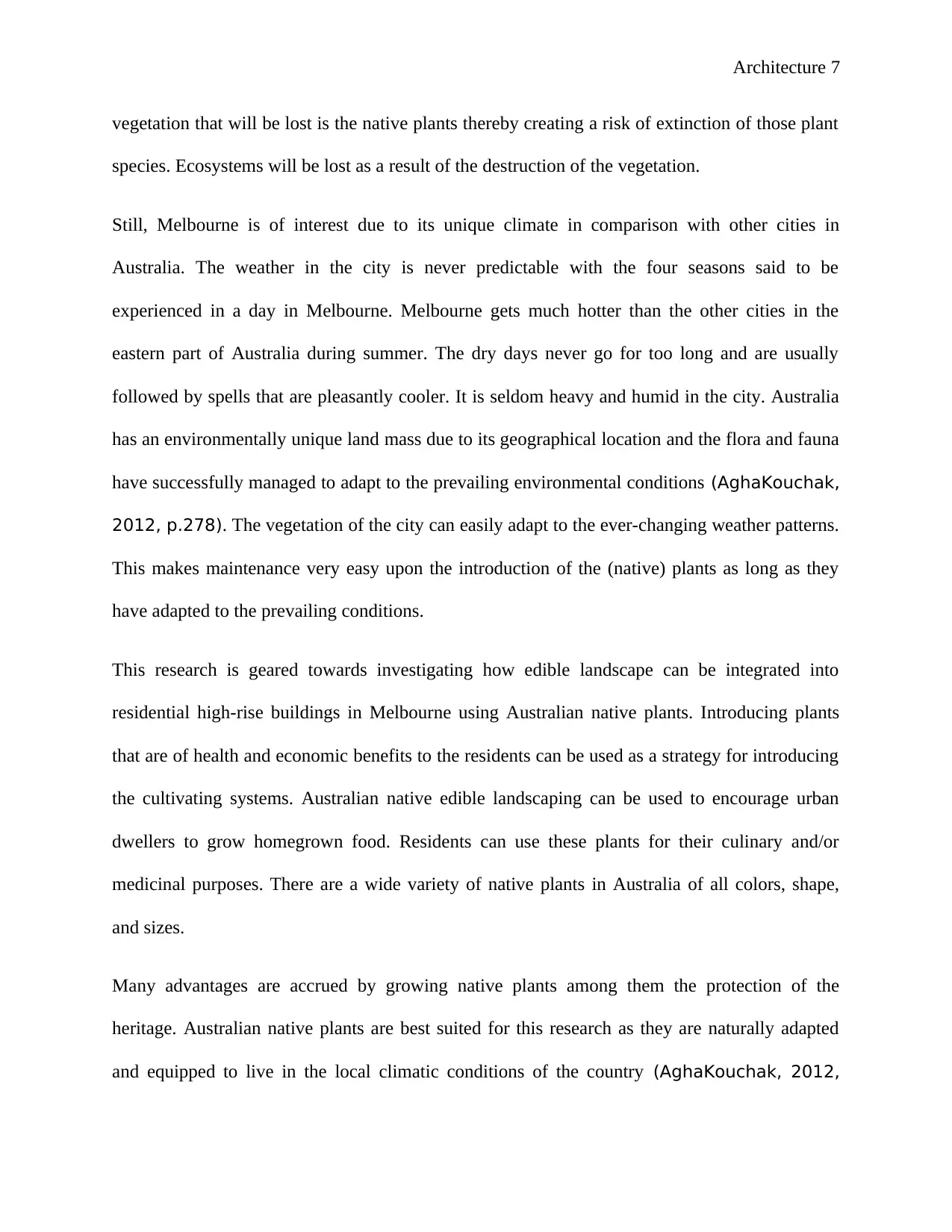
Architecture 7
vegetation that will be lost is the native plants thereby creating a risk of extinction of those plant
species. Ecosystems will be lost as a result of the destruction of the vegetation.
Still, Melbourne is of interest due to its unique climate in comparison with other cities in
Australia. The weather in the city is never predictable with the four seasons said to be
experienced in a day in Melbourne. Melbourne gets much hotter than the other cities in the
eastern part of Australia during summer. The dry days never go for too long and are usually
followed by spells that are pleasantly cooler. It is seldom heavy and humid in the city. Australia
has an environmentally unique land mass due to its geographical location and the flora and fauna
have successfully managed to adapt to the prevailing environmental conditions (AghaKouchak,
2012, p.278). The vegetation of the city can easily adapt to the ever-changing weather patterns.
This makes maintenance very easy upon the introduction of the (native) plants as long as they
have adapted to the prevailing conditions.
This research is geared towards investigating how edible landscape can be integrated into
residential high-rise buildings in Melbourne using Australian native plants. Introducing plants
that are of health and economic benefits to the residents can be used as a strategy for introducing
the cultivating systems. Australian native edible landscaping can be used to encourage urban
dwellers to grow homegrown food. Residents can use these plants for their culinary and/or
medicinal purposes. There are a wide variety of native plants in Australia of all colors, shape,
and sizes.
Many advantages are accrued by growing native plants among them the protection of the
heritage. Australian native plants are best suited for this research as they are naturally adapted
and equipped to live in the local climatic conditions of the country (AghaKouchak, 2012,
vegetation that will be lost is the native plants thereby creating a risk of extinction of those plant
species. Ecosystems will be lost as a result of the destruction of the vegetation.
Still, Melbourne is of interest due to its unique climate in comparison with other cities in
Australia. The weather in the city is never predictable with the four seasons said to be
experienced in a day in Melbourne. Melbourne gets much hotter than the other cities in the
eastern part of Australia during summer. The dry days never go for too long and are usually
followed by spells that are pleasantly cooler. It is seldom heavy and humid in the city. Australia
has an environmentally unique land mass due to its geographical location and the flora and fauna
have successfully managed to adapt to the prevailing environmental conditions (AghaKouchak,
2012, p.278). The vegetation of the city can easily adapt to the ever-changing weather patterns.
This makes maintenance very easy upon the introduction of the (native) plants as long as they
have adapted to the prevailing conditions.
This research is geared towards investigating how edible landscape can be integrated into
residential high-rise buildings in Melbourne using Australian native plants. Introducing plants
that are of health and economic benefits to the residents can be used as a strategy for introducing
the cultivating systems. Australian native edible landscaping can be used to encourage urban
dwellers to grow homegrown food. Residents can use these plants for their culinary and/or
medicinal purposes. There are a wide variety of native plants in Australia of all colors, shape,
and sizes.
Many advantages are accrued by growing native plants among them the protection of the
heritage. Australian native plants are best suited for this research as they are naturally adapted
and equipped to live in the local climatic conditions of the country (AghaKouchak, 2012,
Paraphrase This Document
Need a fresh take? Get an instant paraphrase of this document with our AI Paraphraser
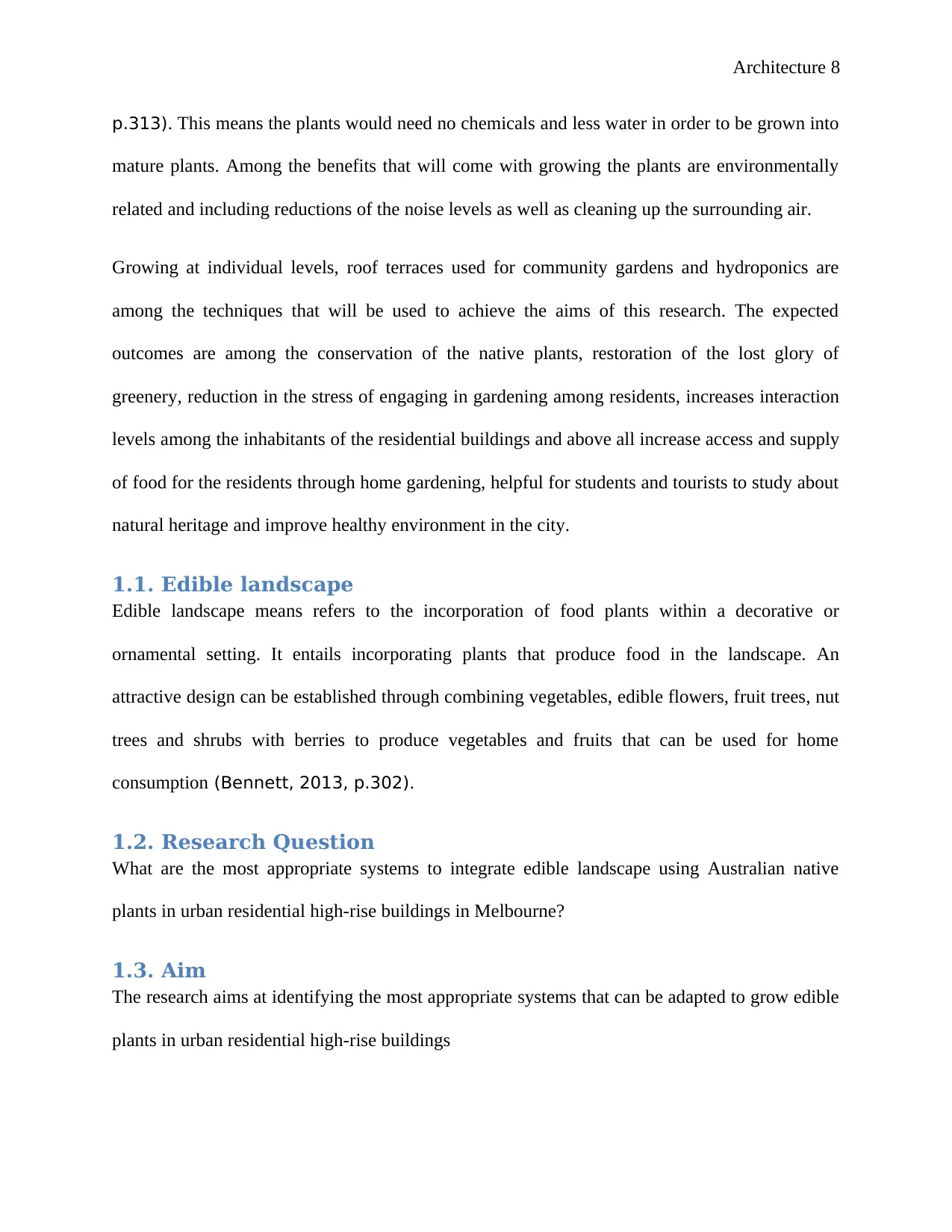
Architecture 8
p.313). This means the plants would need no chemicals and less water in order to be grown into
mature plants. Among the benefits that will come with growing the plants are environmentally
related and including reductions of the noise levels as well as cleaning up the surrounding air.
Growing at individual levels, roof terraces used for community gardens and hydroponics are
among the techniques that will be used to achieve the aims of this research. The expected
outcomes are among the conservation of the native plants, restoration of the lost glory of
greenery, reduction in the stress of engaging in gardening among residents, increases interaction
levels among the inhabitants of the residential buildings and above all increase access and supply
of food for the residents through home gardening, helpful for students and tourists to study about
natural heritage and improve healthy environment in the city.
1.1. Edible landscape
Edible landscape means refers to the incorporation of food plants within a decorative or
ornamental setting. It entails incorporating plants that produce food in the landscape. An
attractive design can be established through combining vegetables, edible flowers, fruit trees, nut
trees and shrubs with berries to produce vegetables and fruits that can be used for home
consumption (Bennett, 2013, p.302).
1.2. Research Question
What are the most appropriate systems to integrate edible landscape using Australian native
plants in urban residential high-rise buildings in Melbourne?
1.3. Aim
The research aims at identifying the most appropriate systems that can be adapted to grow edible
plants in urban residential high-rise buildings
p.313). This means the plants would need no chemicals and less water in order to be grown into
mature plants. Among the benefits that will come with growing the plants are environmentally
related and including reductions of the noise levels as well as cleaning up the surrounding air.
Growing at individual levels, roof terraces used for community gardens and hydroponics are
among the techniques that will be used to achieve the aims of this research. The expected
outcomes are among the conservation of the native plants, restoration of the lost glory of
greenery, reduction in the stress of engaging in gardening among residents, increases interaction
levels among the inhabitants of the residential buildings and above all increase access and supply
of food for the residents through home gardening, helpful for students and tourists to study about
natural heritage and improve healthy environment in the city.
1.1. Edible landscape
Edible landscape means refers to the incorporation of food plants within a decorative or
ornamental setting. It entails incorporating plants that produce food in the landscape. An
attractive design can be established through combining vegetables, edible flowers, fruit trees, nut
trees and shrubs with berries to produce vegetables and fruits that can be used for home
consumption (Bennett, 2013, p.302).
1.2. Research Question
What are the most appropriate systems to integrate edible landscape using Australian native
plants in urban residential high-rise buildings in Melbourne?
1.3. Aim
The research aims at identifying the most appropriate systems that can be adapted to grow edible
plants in urban residential high-rise buildings
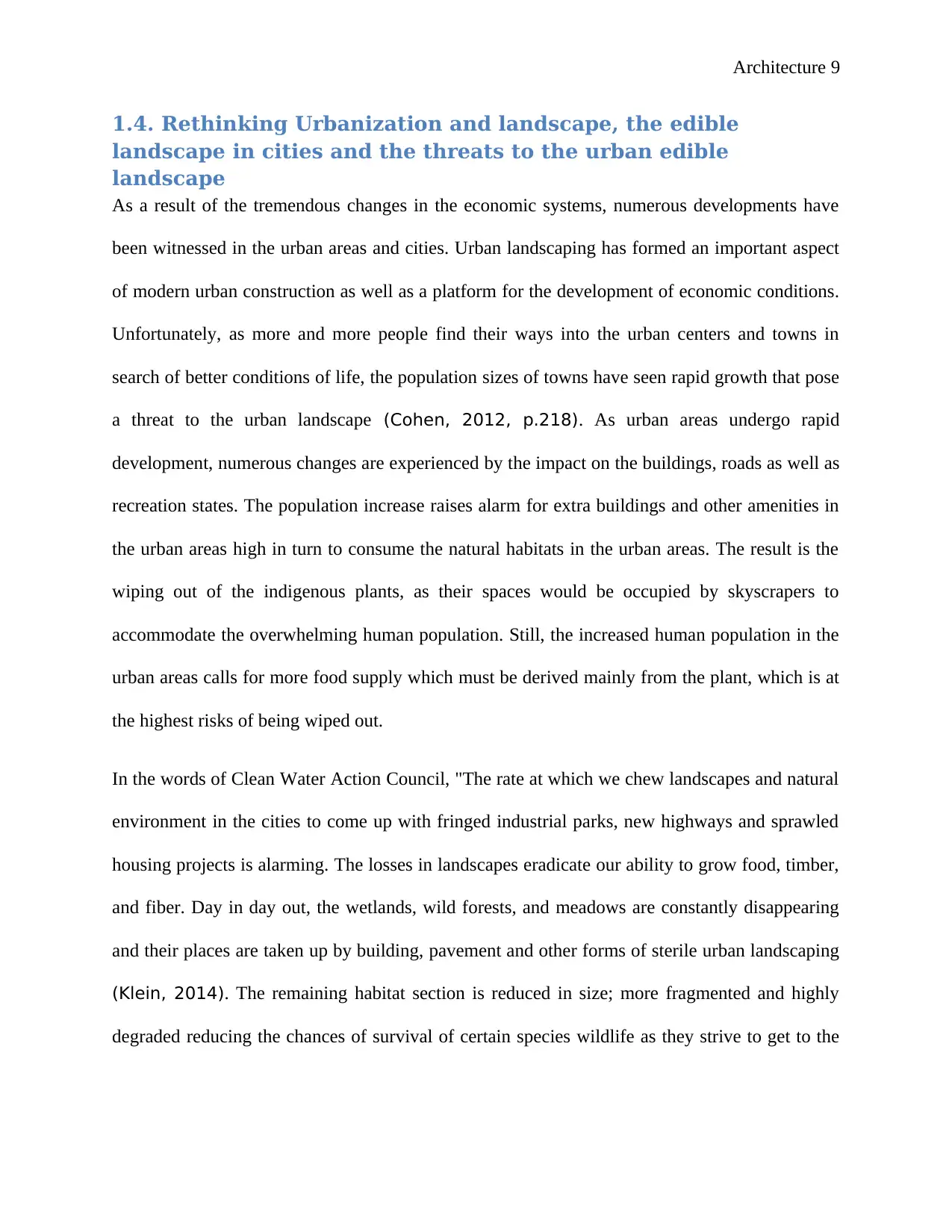
Architecture 9
1.4. Rethinking Urbanization and landscape, the edible
landscape in cities and the threats to the urban edible
landscape
As a result of the tremendous changes in the economic systems, numerous developments have
been witnessed in the urban areas and cities. Urban landscaping has formed an important aspect
of modern urban construction as well as a platform for the development of economic conditions.
Unfortunately, as more and more people find their ways into the urban centers and towns in
search of better conditions of life, the population sizes of towns have seen rapid growth that pose
a threat to the urban landscape (Cohen, 2012, p.218). As urban areas undergo rapid
development, numerous changes are experienced by the impact on the buildings, roads as well as
recreation states. The population increase raises alarm for extra buildings and other amenities in
the urban areas high in turn to consume the natural habitats in the urban areas. The result is the
wiping out of the indigenous plants, as their spaces would be occupied by skyscrapers to
accommodate the overwhelming human population. Still, the increased human population in the
urban areas calls for more food supply which must be derived mainly from the plant, which is at
the highest risks of being wiped out.
In the words of Clean Water Action Council, "The rate at which we chew landscapes and natural
environment in the cities to come up with fringed industrial parks, new highways and sprawled
housing projects is alarming. The losses in landscapes eradicate our ability to grow food, timber,
and fiber. Day in day out, the wetlands, wild forests, and meadows are constantly disappearing
and their places are taken up by building, pavement and other forms of sterile urban landscaping
(Klein, 2014). The remaining habitat section is reduced in size; more fragmented and highly
degraded reducing the chances of survival of certain species wildlife as they strive to get to the
1.4. Rethinking Urbanization and landscape, the edible
landscape in cities and the threats to the urban edible
landscape
As a result of the tremendous changes in the economic systems, numerous developments have
been witnessed in the urban areas and cities. Urban landscaping has formed an important aspect
of modern urban construction as well as a platform for the development of economic conditions.
Unfortunately, as more and more people find their ways into the urban centers and towns in
search of better conditions of life, the population sizes of towns have seen rapid growth that pose
a threat to the urban landscape (Cohen, 2012, p.218). As urban areas undergo rapid
development, numerous changes are experienced by the impact on the buildings, roads as well as
recreation states. The population increase raises alarm for extra buildings and other amenities in
the urban areas high in turn to consume the natural habitats in the urban areas. The result is the
wiping out of the indigenous plants, as their spaces would be occupied by skyscrapers to
accommodate the overwhelming human population. Still, the increased human population in the
urban areas calls for more food supply which must be derived mainly from the plant, which is at
the highest risks of being wiped out.
In the words of Clean Water Action Council, "The rate at which we chew landscapes and natural
environment in the cities to come up with fringed industrial parks, new highways and sprawled
housing projects is alarming. The losses in landscapes eradicate our ability to grow food, timber,
and fiber. Day in day out, the wetlands, wild forests, and meadows are constantly disappearing
and their places are taken up by building, pavement and other forms of sterile urban landscaping
(Klein, 2014). The remaining habitat section is reduced in size; more fragmented and highly
degraded reducing the chances of survival of certain species wildlife as they strive to get to the
⊘ This is a preview!⊘
Do you want full access?
Subscribe today to unlock all pages.

Trusted by 1+ million students worldwide
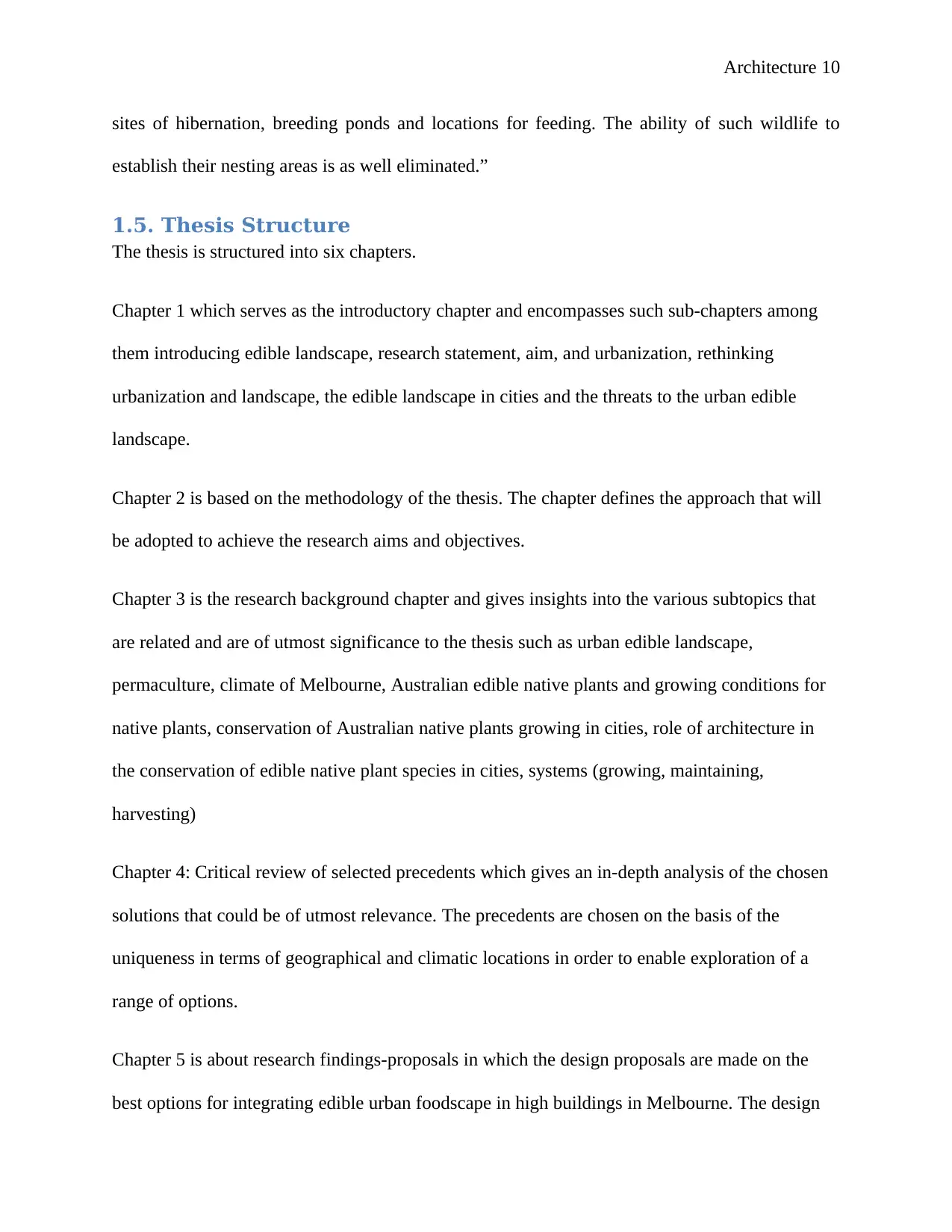
Architecture 10
sites of hibernation, breeding ponds and locations for feeding. The ability of such wildlife to
establish their nesting areas is as well eliminated.”
1.5. Thesis Structure
The thesis is structured into six chapters.
Chapter 1 which serves as the introductory chapter and encompasses such sub-chapters among
them introducing edible landscape, research statement, aim, and urbanization, rethinking
urbanization and landscape, the edible landscape in cities and the threats to the urban edible
landscape.
Chapter 2 is based on the methodology of the thesis. The chapter defines the approach that will
be adopted to achieve the research aims and objectives.
Chapter 3 is the research background chapter and gives insights into the various subtopics that
are related and are of utmost significance to the thesis such as urban edible landscape,
permaculture, climate of Melbourne, Australian edible native plants and growing conditions for
native plants, conservation of Australian native plants growing in cities, role of architecture in
the conservation of edible native plant species in cities, systems (growing, maintaining,
harvesting)
Chapter 4: Critical review of selected precedents which gives an in-depth analysis of the chosen
solutions that could be of utmost relevance. The precedents are chosen on the basis of the
uniqueness in terms of geographical and climatic locations in order to enable exploration of a
range of options.
Chapter 5 is about research findings-proposals in which the design proposals are made on the
best options for integrating edible urban foodscape in high buildings in Melbourne. The design
sites of hibernation, breeding ponds and locations for feeding. The ability of such wildlife to
establish their nesting areas is as well eliminated.”
1.5. Thesis Structure
The thesis is structured into six chapters.
Chapter 1 which serves as the introductory chapter and encompasses such sub-chapters among
them introducing edible landscape, research statement, aim, and urbanization, rethinking
urbanization and landscape, the edible landscape in cities and the threats to the urban edible
landscape.
Chapter 2 is based on the methodology of the thesis. The chapter defines the approach that will
be adopted to achieve the research aims and objectives.
Chapter 3 is the research background chapter and gives insights into the various subtopics that
are related and are of utmost significance to the thesis such as urban edible landscape,
permaculture, climate of Melbourne, Australian edible native plants and growing conditions for
native plants, conservation of Australian native plants growing in cities, role of architecture in
the conservation of edible native plant species in cities, systems (growing, maintaining,
harvesting)
Chapter 4: Critical review of selected precedents which gives an in-depth analysis of the chosen
solutions that could be of utmost relevance. The precedents are chosen on the basis of the
uniqueness in terms of geographical and climatic locations in order to enable exploration of a
range of options.
Chapter 5 is about research findings-proposals in which the design proposals are made on the
best options for integrating edible urban foodscape in high buildings in Melbourne. The design
Paraphrase This Document
Need a fresh take? Get an instant paraphrase of this document with our AI Paraphraser
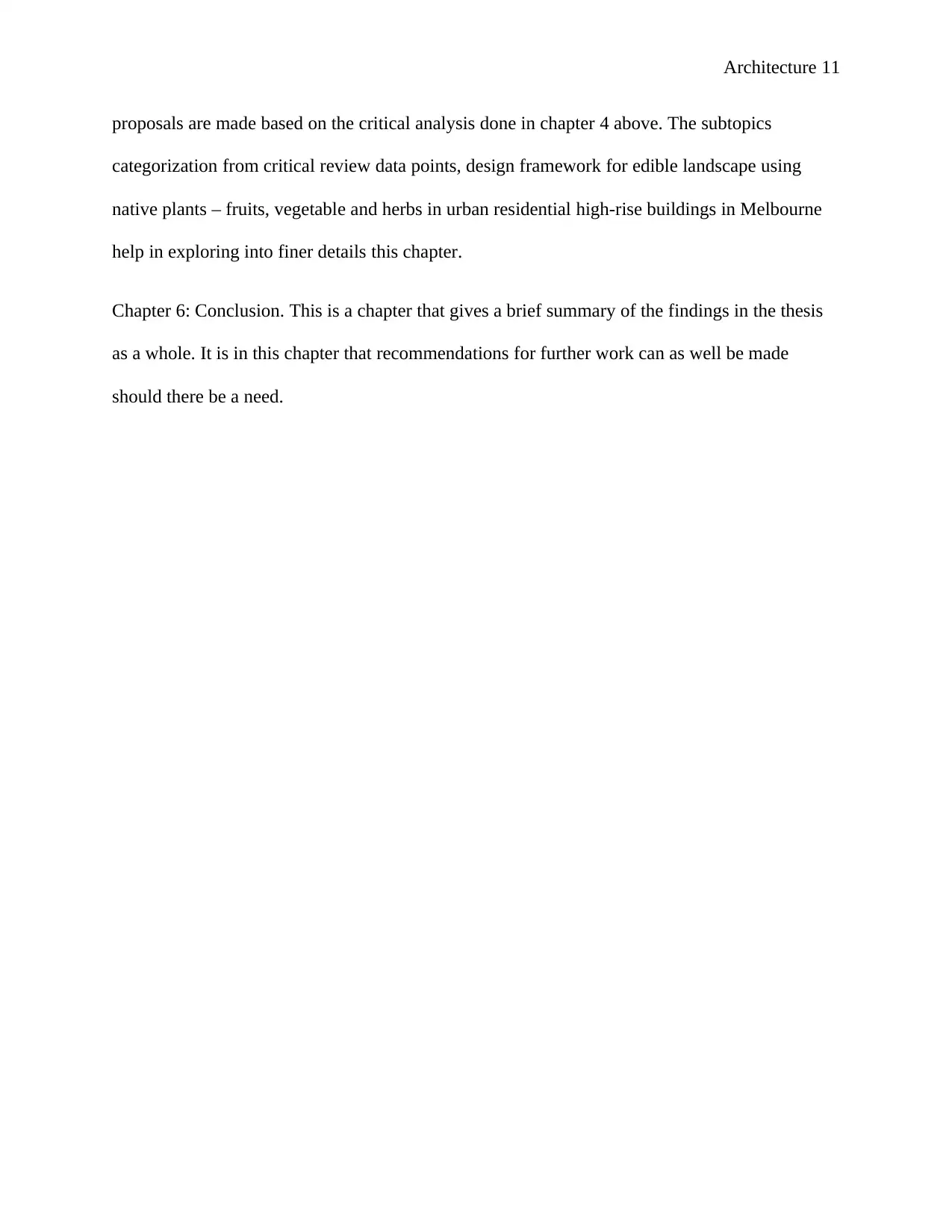
Architecture 11
proposals are made based on the critical analysis done in chapter 4 above. The subtopics
categorization from critical review data points, design framework for edible landscape using
native plants – fruits, vegetable and herbs in urban residential high-rise buildings in Melbourne
help in exploring into finer details this chapter.
Chapter 6: Conclusion. This is a chapter that gives a brief summary of the findings in the thesis
as a whole. It is in this chapter that recommendations for further work can as well be made
should there be a need.
proposals are made based on the critical analysis done in chapter 4 above. The subtopics
categorization from critical review data points, design framework for edible landscape using
native plants – fruits, vegetable and herbs in urban residential high-rise buildings in Melbourne
help in exploring into finer details this chapter.
Chapter 6: Conclusion. This is a chapter that gives a brief summary of the findings in the thesis
as a whole. It is in this chapter that recommendations for further work can as well be made
should there be a need.
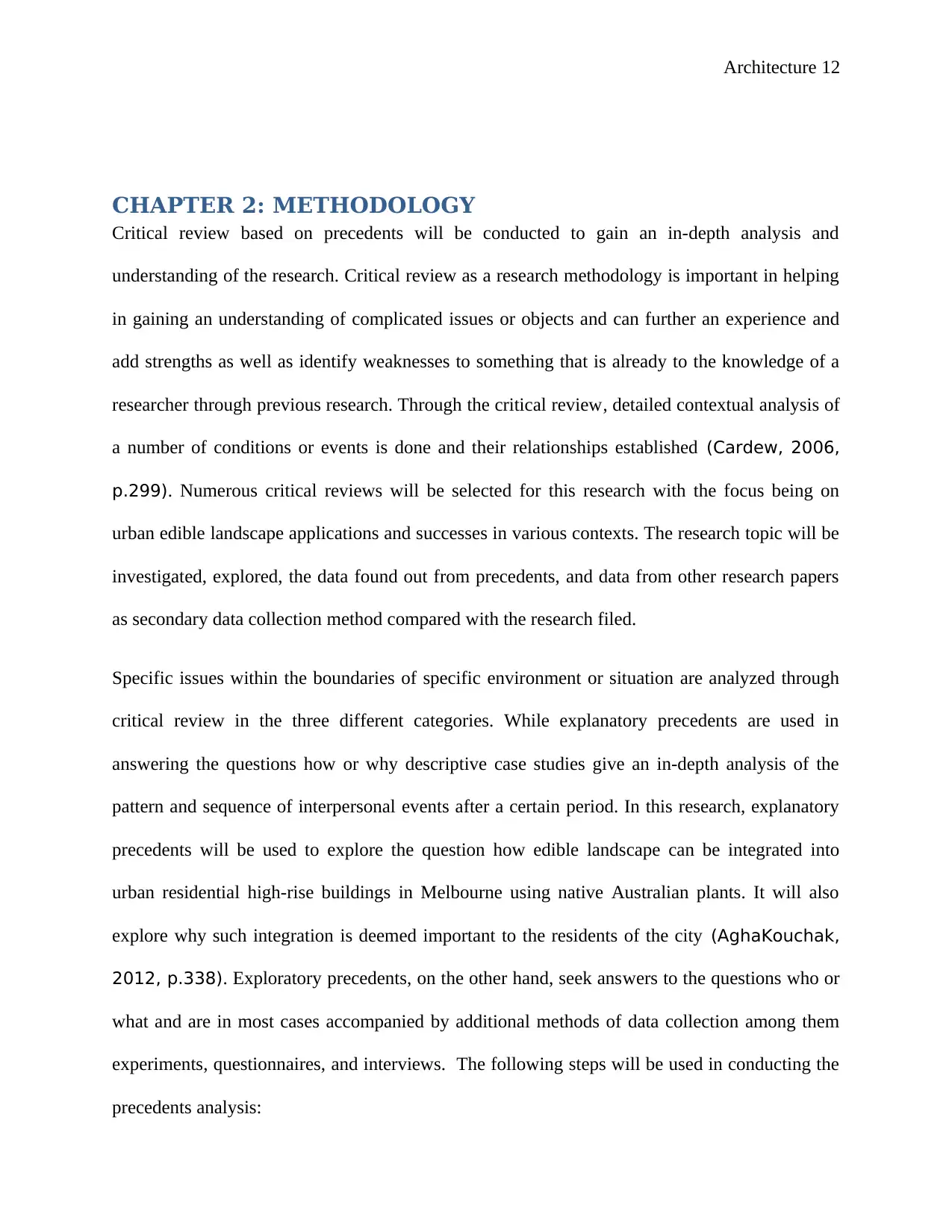
Architecture 12
CHAPTER 2: METHODOLOGY
Critical review based on precedents will be conducted to gain an in-depth analysis and
understanding of the research. Critical review as a research methodology is important in helping
in gaining an understanding of complicated issues or objects and can further an experience and
add strengths as well as identify weaknesses to something that is already to the knowledge of a
researcher through previous research. Through the critical review, detailed contextual analysis of
a number of conditions or events is done and their relationships established (Cardew, 2006,
p.299). Numerous critical reviews will be selected for this research with the focus being on
urban edible landscape applications and successes in various contexts. The research topic will be
investigated, explored, the data found out from precedents, and data from other research papers
as secondary data collection method compared with the research filed.
Specific issues within the boundaries of specific environment or situation are analyzed through
critical review in the three different categories. While explanatory precedents are used in
answering the questions how or why descriptive case studies give an in-depth analysis of the
pattern and sequence of interpersonal events after a certain period. In this research, explanatory
precedents will be used to explore the question how edible landscape can be integrated into
urban residential high-rise buildings in Melbourne using native Australian plants. It will also
explore why such integration is deemed important to the residents of the city (AghaKouchak,
2012, p.338). Exploratory precedents, on the other hand, seek answers to the questions who or
what and are in most cases accompanied by additional methods of data collection among them
experiments, questionnaires, and interviews. The following steps will be used in conducting the
precedents analysis:
CHAPTER 2: METHODOLOGY
Critical review based on precedents will be conducted to gain an in-depth analysis and
understanding of the research. Critical review as a research methodology is important in helping
in gaining an understanding of complicated issues or objects and can further an experience and
add strengths as well as identify weaknesses to something that is already to the knowledge of a
researcher through previous research. Through the critical review, detailed contextual analysis of
a number of conditions or events is done and their relationships established (Cardew, 2006,
p.299). Numerous critical reviews will be selected for this research with the focus being on
urban edible landscape applications and successes in various contexts. The research topic will be
investigated, explored, the data found out from precedents, and data from other research papers
as secondary data collection method compared with the research filed.
Specific issues within the boundaries of specific environment or situation are analyzed through
critical review in the three different categories. While explanatory precedents are used in
answering the questions how or why descriptive case studies give an in-depth analysis of the
pattern and sequence of interpersonal events after a certain period. In this research, explanatory
precedents will be used to explore the question how edible landscape can be integrated into
urban residential high-rise buildings in Melbourne using native Australian plants. It will also
explore why such integration is deemed important to the residents of the city (AghaKouchak,
2012, p.338). Exploratory precedents, on the other hand, seek answers to the questions who or
what and are in most cases accompanied by additional methods of data collection among them
experiments, questionnaires, and interviews. The following steps will be used in conducting the
precedents analysis:
⊘ This is a preview!⊘
Do you want full access?
Subscribe today to unlock all pages.

Trusted by 1+ million students worldwide
1 out of 44
Your All-in-One AI-Powered Toolkit for Academic Success.
+13062052269
info@desklib.com
Available 24*7 on WhatsApp / Email
![[object Object]](/_next/static/media/star-bottom.7253800d.svg)
Unlock your academic potential
Copyright © 2020–2025 A2Z Services. All Rights Reserved. Developed and managed by ZUCOL.